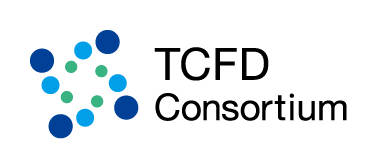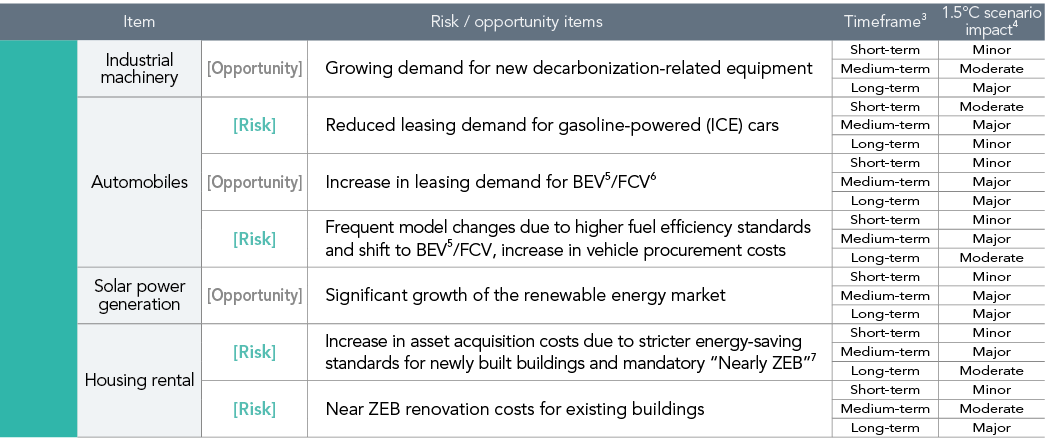Response to TCFD
The Ricoh Leasing Group recognizes that dealing with environmental issues, including climate change, is one of its most important management issues. Accordingly, the Ricoh Leasing Group is working on Mitigate and adapt to climate change and resource recycling, with "Contribute to clean global environment" as its materiality.
In August 2019, we announced our support for the Task Force on Climate-Related Financial Disclosure (TCFD), and in fiscal 2020, we joined TCFD Consortium, a company for discussion among supporters and financial institutions.Based on our TCFD recommendations, we will analyze the risks and opportunities that climate change may have on our business, reflect them in our group strategies and risk management, and disclose appropriate information.


Governance
Until now, the Risk Management Committee of our group has made management decisions at the Executive Committee after the formulation of financial risk assessment and prevention plans.In April 2020, we established the Sustainability Committee, a committee responsible for climate change-related issues.The Committee is chaired by the Director in Charge of Sustainability Promotion, and is composed of Managing Executive Officer and above and the challenge managers of headquarters who face sustainability ESGs.These meetings are held once a quarter to convene representatives of business divisions according to the themes to be discussed, and to review and discuss sustainability issues from a medium-to long-term perspective.Climate-change risk items are reviewed and risk and opportunity assessments are conducted. The results are incorporated into Mid-term Management Plan as a business strategy. These results are reflected in the targets for each business year.
Strategy
We assume that the transition to a decarbonized society and climate change will lead to increased extreme weather conditions that could affect our customers' businesses.In light of the frequent occurrence of natural disasters caused by climate change in our country in recent years, we conducted a qualitative scenario analysis of five categories of our business that are concerned about the financial impact of climate change.As a result, we analyzed quantitatively the items identified as having a large impact on the business, and estimated the financial impact.
1.5°C scenario※1
Scenarios in which severe measures are taken against climate change and temperature increases are suppressed to about 1.5°C.
4°C scenario※1
Scenarios in which climate change measures are not taken and temperatures rise by about 4°C.
- Leased property (office equipment※2, automobile, industrial machinery)
- Photovoltaic power generation
- Housing rental
- ※1As a result of the qualitative analysis, no quantitative analysis has been conducted on the physical risks (impacts on damage caused by floods, storm surges, and temperature increases) in the 4°C scenario, based on the judgment that the impacts on our business are small.
The parameters for estimating the impact are as follows: IEA "World Energy Outlook 2021", trends in the number of vehicles owned worldwide (less than 2°C/2°C/3°C) and their composition (3°C), Energy Technology Perspectives2017 Fig5, IEA, 2017, and the energy conservation target in the long-term energy supply-demand forecast "Current status and future of energy conservation measures in the 2030 energy mix", solar power generation cost (1.5°C) 6th energy basic plan related data "Energy supply-demand forecast in 2030" (Agency for Natural Resources and Energy, 2021), Growing Green Industry [Green Growth Strategy] (1.5°C), Green Growth Strategy associated with carbon neutral in 2050 years (Cabinet Office). - ※2Regarding office equipment, based on the assumption that leased assets were damaged due to wind and flood damage, the effectiveness of the analysis was carefully examined in consideration of the utilization of insurance, etc., and based on the judgment that the impact of climate change on our business was small, the analysis was excluded from the scope of quantification analysis.
Risks and opportunities
Risks and opportunities associated with climate change affect Ricoh Lease mainly as shown in the table below.

- ※3Short-term: Current to 2025, Medium-term: 2026 to 2030, Long-term: 2031 to 2050
- ※4Large: over 3 billion yen, Medium: 1 to 3 billion yen, Small: less than 100 million yen
- ※5BEV(Battery Electric Vehicle): An electric vehicle that runs 100% on electricity, one type of electric vehicle (EV)
- ※6FCV(Fuel Cell Vehicle): A fuel cell vehicle, wherein a motor is rotated by electric energy generated by a chemical reaction of hydrogen and oxygen in a fuel cell
- ※7Nearly ZEB(Zero Energy Building): Buildings with 50% or more reduction in primary energy consumption from the criterion primary energy consumption except for renewable energy (ZEB Ready), and buildings with 75% or more and less than 100% reduction in primary energy consumption from the reference primary energy consumption by adding renewable energy
Impact on our business
Scenario analysis showed that in both transition (1.5°C) and physical (4°C) scenarios, climate change had a generally limited short-term negative impact on our group's businesses.In addition, the analysis shows that opportunities are larger in total than risk impacts, and that sales and profits are expected to increase in the 1.5°C scenario.In the future, based on the results of this analysis, we will expand opportunities in our business activities and strengthen and promote measures to reduce the burden of climate change over the medium to long term.
Risk Management
In order to identify significant financial impacts, the Group evaluates risks such as climate change and natural disaster risks on two axes: economic impacts and frequency of occurrence, which include financial definitions.As for the strategic impact, the Executive Committee discusses measures against physical risks and other matters.These risks are managed by the Risk Management Committee, and climate change measures are examined by the Sustainability Committee and discussed and decided by the Management Committee.At the same time, in order to realize the opportunity-to long-term vision of "Circulation-Creating Company," we are working to reduce the environmental burden and expand our business by expanding renewable energy in Mid-term Management Plan.
Indicators and targets
We have set group-to long-term targets for reducing CO2 emissions based on the 1.5°C target for SBTi※8.For Scope 1 and Scope 2, the target year for net-zero CO2 emissions was advanced from 2050 to 2030.In fiscal 2022, Scope 2 CO2 emissions from electricity use (510 tons per CO2) were converted into real renewable energy through the use of the Tracked FIT-Non-Fossil Certificate ※9.In Mid-term Management Plan (FY2023-FY2025), ① cumulative funding for The Environmental Field was 400 billion yen, ② renewable power generation was 205, 700MWh (FY2022: 112, 872MWh), and ③ the number of EVs handled increased to Non-Financial Targets, aiming to solve environmental issues.
- ※8SBTi(Science Based Targets initiative): Collaborative initiative that promotes the setting of a reduction target to keep the world average temperature rise from climate change at 1.5°C compared to the pre-industrial level
- ※9Non-fossil certificates are certificates that distinguish the environmental value of electricity derived from non-fossil power sources from the value of electricity themselves and that link the identification of power sources to renewable energy sources certified by the Fixed Price Purchase Program (FIT Law) and the information on production areas are called FIT non-fossil certificates with tracking.
